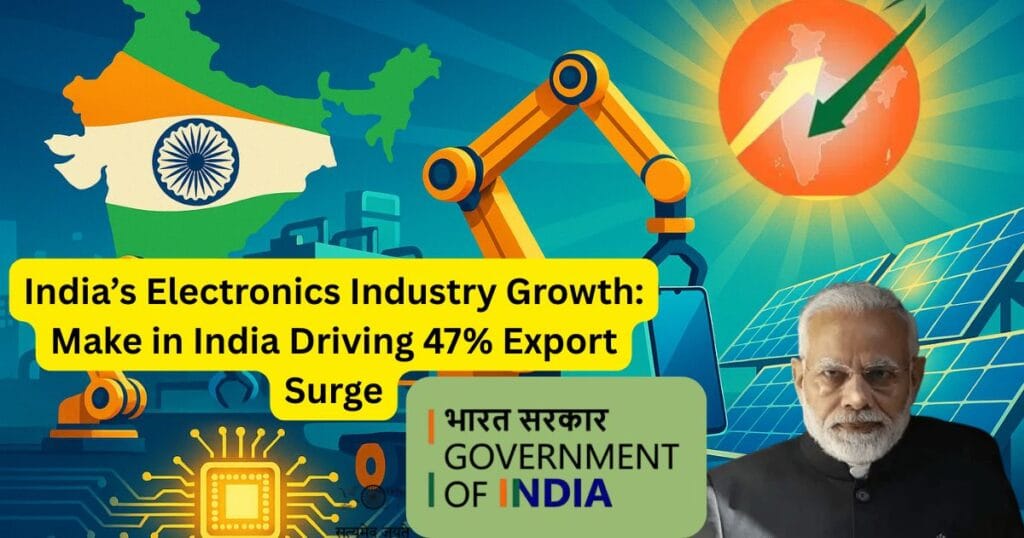India’s electronics industry has emerged as a cornerstone of the nation’s economic growth and self-reliance. This sector is not only creating millions of jobs but also positioning India as a key player in the global market. In the first quarter of 2025-26, electronics exports surged by an impressive 47%, reaching $12.4 billion. A decade ago, in 2014-15, the industry’s production was just $31 billion, which has now skyrocketed to $133 billion. Notably, India has become the world’s second-largest mobile phone manufacturer, a testament to the success of the Make in India initiative.

This article dives into the growth, challenges, and future potential of India’s electronics sector. Whether you’re a curious reader, a small business owner, or a policymaker, this guide offers a comprehensive look at how India is transforming into a global electronics hub.
Key Statistics of Electronics Industry: A Snapshot of Progress
The electronics industry in India has shown remarkable growth. Here are some key figures that highlight its progress:
- Export Surge: In Q1 2025-26, electronics exports grew by 47% to $12.4 billion.
- Production Growth: From $31 billion in 2014 to $133 billion today.
- Mobile Manufacturing Units: From just 2 units in 2014 to over 300 now.
- Global Rank: India is now the second-largest mobile phone manufacturer globally.
| Details | 2014-15 | 2025-26 (Q1) |
|---|---|---|
| Production ($ billion) | 31 | 133 |
| Exports ($ billion) | Very low | 12.4 |
| Mobile Units | 2 | 300+ |
| Export Growth (%) | — | +47% |
These numbers reflect the rapid expansion of India’s electronics sector and its role in driving self-reliant India.
Role of Make in India: Transforming the Industry of Electronics Industry
The Make in India campaign has been a game-changer for the electronics industry. Key government initiatives have fueled this transformation:
- Production Linked Incentive (PLI) Scheme: The government has pledged $17 billion to boost manufacturing in electronics, smartphones, semiconductors, and IT hardware. This has encouraged companies to set up factories in India.
- Electronics Manufacturing Clusters (EMCs): These clusters provide world-class infrastructure like power, roads, and training centers. For example, the EMC 2.0 cluster in Gautam Buddha Nagar, Uttar Pradesh, built at a cost of ₹417 crore, is expected to create 15,000 jobs and attract ₹2,500 crore in investments.
- Tax Benefits and Simplified Rules: Reduced taxes and streamlined licensing processes have made it easier for domestic and foreign companies to invest in India.
These policies have not only boosted local production but also strengthened India’s position in the global supply chain.
Mobile Manufacturing: From 2 to Over 300 Units
In 2014, India had just 2 mobile manufacturing units. Today, this number has grown to over 300, thanks to Make in India and contributions from small and large companies.
- Early Days: Initially, India focused on assembling mobile parts to create finished phones.
- Current Scenario: Companies now manufacture complex components like cameras, displays, batteries, and software locally, enhancing production quality and depth.
- Role of SMEs: Local small and medium enterprises (SMEs) supply mobile components, reducing costs and ensuring faster supply chains.
- Job Creation: This growth has generated around 12 lakh direct and indirect jobs.
| Year | Units | Production Value (₹ Crore) | Key Developments |
|---|---|---|---|
| 2014 | 2 | 18,900 | Initial assembly |
| 2020 | ~100 | 1,00,000 | Expansion of OEMs and ODMs |
| 2025 | 300+ | 4,22,000 | Value addition, local suppliers |
This progress has made India a global leader in mobile manufacturing and a symbol of self-reliance.
ALSO READ- Drug Prices Reduced in India – NPPA’s New Rules from April 2025
Export Trends: India’s Growing Global Presence in Electronics Industry
In Q1 2025-26, electronics exports surged by 47%, reaching $12.4 billion. Mobile phones contributed the most, with a 55% increase to $7.6 billion. Non-mobile electronics, such as solar panels, chargers, and printed circuit boards (PCBs), also saw a 37% rise in exports.
- Key Markets: The USA, Europe, the Middle East, and Asian countries are buying Indian products due to their competitive pricing and quality.
- Top Products: High-tech smartphones, solar panels, and chargers are in high demand.
This export growth is bringing in foreign exchange and boosting local job creation and production.
Job Creation and Skill Development in Electronics Industry: Empowering Millions
The electronics industry has been a major driver of employment in India. By March 2024, hiring in this sector grew by 154%, with an estimated 10 lakh new jobs expected by 2025.
- Telecom Sector Demand: Roles like machine operators, quality assurance professionals, and testing specialists are in high demand.
- Women’s Participation: 78% of the workforce in this industry comprises women, a significant milestone.
- Salary Range: Average monthly salaries range from ₹18,000 to ₹32,000.
- Skill Development: Programs like Skill India Digital are training youth in technical and digital skills, preparing them for industry demands.
This growth is not just creating jobs but also strengthening India’s economic and technical capabilities.
Innovation and R&D: India’s Technological Leap
India’s Electronics Industry is making strides in innovation and research and development (R&D), particularly in solar technology and hardware-software integration.
- Solar Technology: Indian startups have developed advanced solar panels using technologies like PERC, HJT, and TOPCon, offering 21-24% higher efficiency. For instance, Tata Power Solar has pioneered floating solar projects that generate stable power on water surfaces.
- Smart Systems: Startups are creating smart inverters and IoT-based monitoring systems to save energy and improve productivity.
- Local Production: Companies like Feston Solar have set up inverter manufacturing units in Chennai, boosting local production and R&D.
These innovations are making India self-reliant while supporting environmental sustainability and global competitiveness.
Challenges in Electronics Industry: Supply Chain Bottlenecks

Despite its growth, the electronics industry faces several challenges:
- Semiconductor Dependency: Over 70% of semiconductors and chips are imported, primarily from China.
- Raw Materials: Importing rare earth minerals and machinery increases production costs.
- Logistics: Delays and complex supply chain processes add to costs.
Government Solutions:
- PLI Scheme: Incentives for local semiconductor production.
- EMC Clusters: Promoting local manufacturing.
- PM Gati Shakti: Improving logistics infrastructure.
- Simplified Rules: Tax breaks and easier licensing to attract investments.
These steps are helping reduce India’s reliance on foreign supplies and strengthening its supply chain.
ALSO READ- Made-in-India Semiconductor Chips: India’s Leap Toward Self-Reliance in Tech
Foreign Investment: Global Companies Join the Race
In 2025, the Electronics Industry attracted $17.4 billion in foreign direct investment (FDI). Companies like Samsung, Xiaomi, Intel, and Qualcomm are expanding their manufacturing units in India.
- Joint Ventures (JVs): Foreign and Indian companies are collaborating to boost production.
- Technology Transfer: These partnerships bring advanced technology and expertise to India.
This investment is strengthening India’s role in the global supply chain.
Future Opportunities: A Bright Horizon
The electronics industry in India is poised for further growth, with opportunities in:
- Semiconductors and Batteries: Increased investment in chip and battery manufacturing.
- Solar and Green Technology: Growing demand for eco-friendly solar panels and batteries.
- Value Addition: Moving beyond assembly to producing complex components locally.
5 Steps for Companies:
- Invest in semiconductor and battery manufacturing.
- Prioritize R&D and innovation.
- Build local supplier networks.
- Focus on green technologies and sustainability.
- Form global partnerships and joint ventures.
Guide for SMEs/MSMEs: Tapping the Boom
Small and medium enterprises (SMEs/MSMEs) can seize opportunities in the electronics sector with these steps:
- Udyam Registration: Register for free on udyamregistration.gov.in using Aadhaar, PAN, and business details.
- TEC Certification: Obtain certification for electronics products at mtcte.tec.gov.in.
- Government Schemes: Apply for PLI and EMC schemes to access funding and support.
- Vendor Registration: Partner with large brands as suppliers to reduce costs and ensure timely delivery.
- Skill Development: Train workers through Skill India programs to improve product quality and efficiency.
These steps will help SMEs/MSMEs thrive in this fast-growing industry.
Policy Recommendations: Strengthening the Sector
To ensure sustained growth, policymakers should:
- Establish component incubators for semiconductors, raw materials, and high-tech components.
- Create export facilitation centers to streamline customs, documentation, and logistics.
- Improve logistics infrastructure with multimodal hubs and digital tracking systems.
- Offer R&D tax credits and funding to encourage innovation in semiconductors and green technologies.
ALSO READ- Foxconn’s iPhone 17 Factory in Bengaluru: A New Chapter for India’s Tech Advancement
Conclusion: A Bright Future Awaits for Electronics Industry
India’s electronics industry has achieved remarkable milestones, including a 47% export growth, $133 billion in production, and becoming the world’s second-largest mobile manufacturer. The Make in India initiative, PLI schemes, and local production have been key drivers. Over the next 3-5 years, focusing on semiconductors, green electronics, and value addition will position India as a leader in the global electronics supply chain, paving the way for a self-reliant future.
How has India’s electronics export grown so rapidly?
Government policies like the PLI scheme, EMC clusters, and improved infrastructure have boosted production and quality, leading to a 47% export surge.
Are major brands manufacturing in India?
Yes, brands like Samsung, Xiaomi, and Lava have set up manufacturing units in India, enhancing production and creating jobs.
How can SMEs benefit from this industry?
SMEs can join as vendors, leverage PLI schemes, and build local supply networks to grow sustainably and access global markets.
Ready to be part of India’s booming electronics industry? Whether you’re a small business owner, an aspiring entrepreneur, or a professional looking to upskill, now is the time to act!
- For SMEs/MSMEs: Register on udyamregistration.gov.in today and tap into PLI schemes to grow your business. Start supplying to major brands and join the self-reliant India movement!
- For Job Seekers: Enroll in Skill India Digital programs to gain technical skills and secure high-paying jobs in the electronics sector.
- For Investors: Explore opportunities in semiconductors, solar technology, and green electronics to be part of India’s global rise.
- Stay Informed: Subscribe to our newsletter for the latest updates on the electronics industry, Make in India initiatives, and more.
Don’t miss out—take the first step towards a brighter, self-reliant future today! Share this article with your network and join the conversation about India’s electronics revolution!


